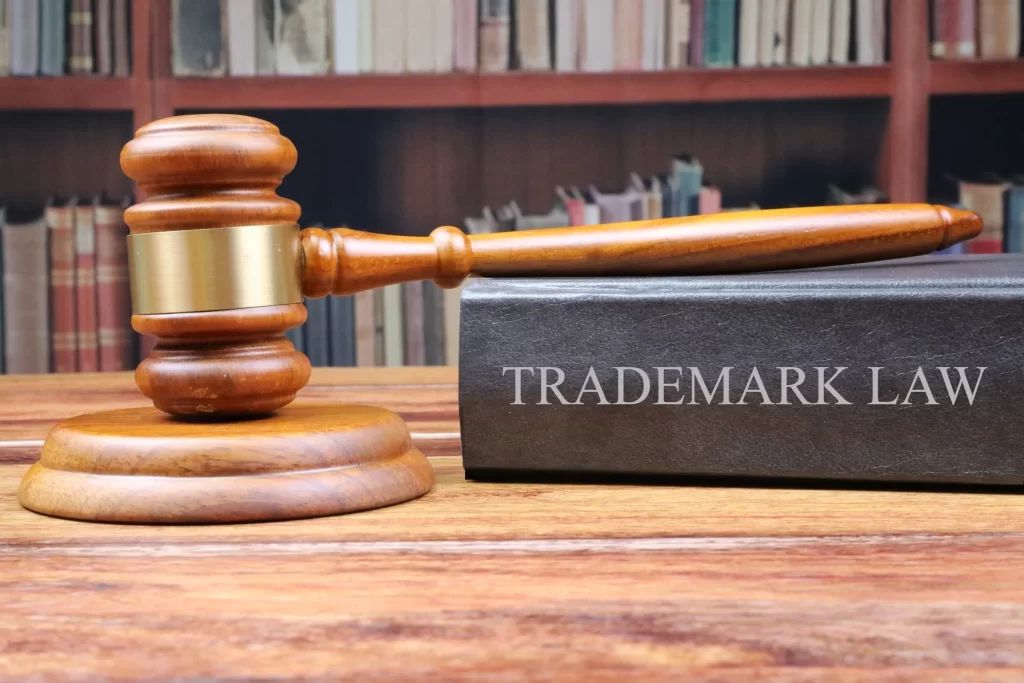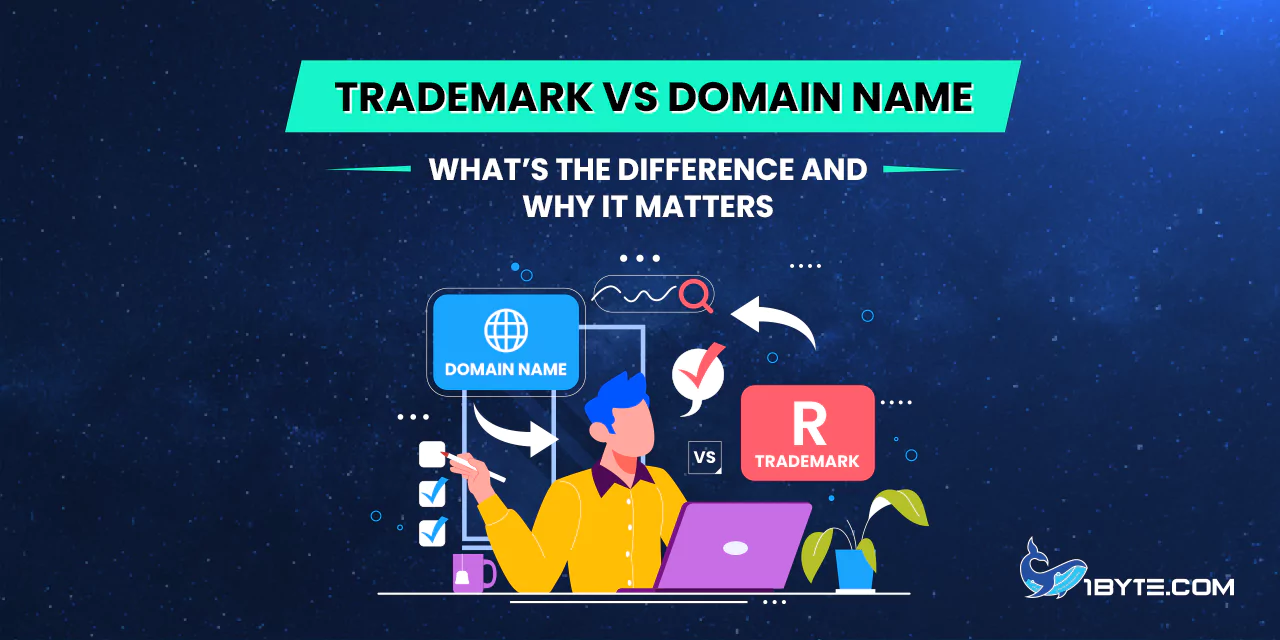Many new businesses are confused when it comes to trademark vs domain name issues. They often assume that the right to the name is granted by purchasing a domain name, or that the right to the name is reserved with the registration of a trademark. However, trademarks and domain names are two different assets that serve different purposes in the building and protection of a brand. Both of these are popular – by the end of 2024 there were 364.3 million domain names registered in all top level domains and in 2023 approximately 11.6 million applications for trademarks were filed across the world. These numbers have been used to draw attention to the prevalence of both tools. However, it is important to realize that the domain name is not the same as a trademark and vice versa.
Trademarks are the legal protections for brand names (like names, logos or slogans) in commerce. On the other hand, a domain name is more like an online address that is used to locate a website. Owning YourBrand.com provides a business with a web presence, but does not automatically provide the business with trademark protection for “YourBrand” in the marketplace. Likewise, just because a company owns a trademark on a name doesn’t mean it will be able to obtain the corresponding .com domain if somebody else was there to beat that to it. In short, trademarks and domain names are two systems of two different rules.
Understanding the difference between the two is not a technicality – it has real consequences for businesses. In the remaining parts of this article from 1Byte, we shall describe each concept, discuss the difference between them, and the importance of maintaining both.

What is a Trademark?
A trademark is a type of intellectual property which can legal protection of a brand name, logo, or other distinguishing mark of goods and services. It grants the owner the exclusive right to use that mark in commerce in certain categories and in certain areas. For example, a trademark that has been registered to a company can stop their competitors in the same industry from using a confusingly similar name or logo. Trademarks come in many forms – a business name, a product name or a slogan may qualify as a trademark; a symbol or design may qualify as a trademark if it is used to indicate the source of the goods or services to which it relates.
Trademarks are registered (mostly) and are protected by law. Once granted, a trademark gives its owner the right to legally prevent others from using identical or very similar marks in a way that could defuse the consumer. This protection is usually territorial – a trademark is valid in the country or area where the trademark is registered (for example, a US trademark or an EU trademark). Trademarks also tend to be assignable to certain classes of goods or services, and so it is possible for two identical names to co-exist if they are in different industries or different countries.
To obtain a trademark, one typically files an application for it with a government IP office (for example, the USPTO in the United States) and goes through an examination process. Office Examines to make sure the mark is distinctive and not too similar to any existing marks in the same class. This process can last months or even more than a year, and is often subject to fees and legal review. Once the trademark has been registered, it may continue for ten years (in many jurisdictions) and may be renewed indefinitely provided continuing use is made of the trademark and the appropriate maintenance documents are filed.

What is a Domain Name?
A domain name is a human-friendly web address of a specific website. It’s the text one types into a web browser to visit a web site – for example, nike.com or yourbrand.com. Domain names are online names for businesses or individuals on the internet – like an street address for a physical store front. They are an important element to the presence and branding of a company online. In practice, most business try to obtain a domain name that matches their brand name or trademark if possible.
Unlike trademarks, domain names are not checked to see if they are unique in an industry or region – they are globally unique strings in each domain extension. This means if someone registered a particular name in the .com space, nobody else in the world can register that exact same .com space at the same time. Domains are acquired on a first come first serve basis through accredited registrars. There is no review for “confusing similarity” or industry conflict when registering a domain, if the name is available and the registration fee is paid, it’s yours. Registration is very fast (sometimes only takes a few minutes online) and relatively cheap (perhaps $10 – $20 a year for common domains).
It’s important to note that simply owning a domain name does not entitle the owner of that name to have trademark rights for that domain. The domain is an address and not a registration of a name of a business. For example, if someone registers starship.com as a domain, he or she has control of that web address, but he or she doesn’t automatically have a trademark on “Starship” for products or services. Another company could still trademark “Starship” for their business if the domain owner hasn’t done so, and conflicts could arise.
Conversely, while ownership of a trademark on a name doesn’t give a company the right to take a domain away from someone else, the company would have the right to do so if it can prove that the domain was registered in bad faith. Domain names also have to be renewed from time to time (usually once in a year or few years). If the owner forgets to renew a domain it may become available for others to register quite quickly. In that sense a domain name is more of a lease to an address while a trademark is more like owning a piece of intellectual property.
Trademark vs Domain Name: Key Differences
Although trademarks and domain names are both concerned with names and branding, trademarks and domain names function in very different ways. Here are some important differences between a trademark and a domain name:
- Type of Right: A trademark is a legal right – it is an intellectual property asset that provides exclusive right to the owner to use a mark in a certain context. A domain name is a technical address – it gives a location on the internet for a web address, but it does not imply any legal rights to the name outside of the domain system. In other words, a trademark is a tool of brand identity on the market, and a domain is a tool of internet navigation.
- Global Uniqueness vs. Territorial Use: Domain names are globally unique. Only a particular person or organization can have a particular domain (such as example.com) at a time, anywhere in the world. In contrast, trademarks are territorial and categorised. Different companies can trademark the same name in different countries or in different industries without violating each other. For example, there can only be 1 delta.com domain. Yet the name “Delta” is trademarked by an airline, a faucet manufacturer and other businesses in different fields. This is because a domain name is unique throughout the world for a specific address whereas trademarks can coexist if the markets or regions that the marks serve do not overlap.
- Registration Process: The process of getting a domain name is quick and is on the first come, first served basis. You just go and check if the domain is available, and just get it registered through a registrar and you don’t have to prove anything. Trademark registration is more time consuming and is subjected to formal examination. One has to apply to an IP office, pay fees, and wait months in many cases for approval. The trademark office can reject an application if the proposed trademark is not distinctive or if it is too similar to another trademark. Essentially, domain registration is a business transaction, while trademark registration is a legal process – involving substantive review.
- Cost and Maintenance: Domain names usually come with a low annual fee (of the order of tens of dollars per year), and the domain name needs to be renewed on time in order to remain the owner. Trademarks have higher up-front costs (filing fees, perhaps a few hundred dollars per class in the U.S.) and perhaps legal fees and have to be renewed less often (every decade in many jurisdictions) with some evidence of continued use. If a domain isn’t renewed it can expire and someone else may grab it, although a trademark, when registered, may forever in properly renewed (even if there’s a grace period for renewal).
- Scope of Protection: A trademark, therefore, provides its owner with legal rights to exclude others from using a confusingly similar name or mark in the marketplace for related goods/services. It safeguards the brand reputation and facilitates consumers to know the origin of products. A domain name will not by itself prevent others from using the same name for other purposes; it only prevents others from using the exact address on the internet. For example, you own yourbrand.com, but it does not prohibit someone else from having that domain name, but it will not prevent another company in another country (or in another industry) from using “YourBrand” as their business name or trademark.
- Types and Uses: Trademarks can be words, logos, slogans, sounds, hues, or anything in between – they can be whatever they need to be as long as they are uniquely recognizable as the origin of a product or service. Domain names are restricted to the characters permitted in URLs (letters, numbers, and hyphens) used in Web addresses. Also, domain names are mostly used in the digital world (for website URLs, email addresses, etc), but trademarks are used in the commercial world (on products, packaging, advertising, etc). As one brand protection firm puts it, domain names only operate in the digital world whereas trademarks only operate in the real world.
In essence, a trademark is like owning the brand name and a domain name is like owning a piece of internet real estate. They both complement each other but are not interchangeable.

Why It Matters to Secure Both
Understanding the differences between trademarks and domain names is critical because failure to give attention to either one can have serious consequences for a business. A company’s legal security, as well as its visibility online, both hang in the balance. Here are a few reasons why it is important to pay attention to both:
- Avoiding Legal Disputes and Rebranding Costs: If a company starts with only a domain name and no trademark, it may end up in a situation where there are conflicts with other companies. There have been cases where a small startup put together a brand under a name, only to receive a letter of a cease and desist from an existing trademark owner, resulting in a complete rebrand. For example, one UK startup spent two years growing their brand, but a US company held the trademark to that name and demanded that they stop using their name – the result was a costly rebrand and lost goodwill. Rebranding isn’t cheap: an average small business can spend $10,000- $50,000 in a rebrand, when forced to change a name, not to mention the loss of customer recognition. In contrast, early registration of a trademark (for as little as a few hundred dollars in fees) can avoid such expensive headaches. In fact, the average trademark infringement lawsuit may cost $120,000 to $750,000 in legal fees, while a USPTO trademark application may cost around $250. The difference is huge so proactive trademarking is a smart investment.
- Preventing Cybersquatting and Domain Loss: If a company focuses only on trademarks and ignores domain names, it could find that someone else has grabbed the brand’s domain. Owning a trademark does not automatically grant the matching domain name, especially if the domain was registered by another party in good faith. Sometimes, unscrupulous actors will register domain names that match popular brand names – a practice known as cybersquatting – hoping to resell them at a profit or misuse them. This is a common problem: in 2024, trademark owners filed 6,168 domain name dispute cases with the World Intellectual Property Organization (WIPO) under its UDRP system. That figure was among the highest on record, highlighting how often businesses must fight to reclaim domains that infringe on their trademarks. In these disputes, trademark owners often win; over 95% of UDRP decisions result in the domain being transferred to the trademark holder. But pursuing a dispute can take time and money. It’s far better for businesses to register key domains preemptively. Consider an example where a company secured a trademark but not the .com domain: an Australian business found that someone else owned their exact-match .com and was demanding $33,000 for it. Paying such a “ransom” or going through a legal battle could have been avoided by registering the domain early for a few dollars.
- Protecting Brand Reputation and Customer Trust: A company’s trademark and its domain name are both pillars of a company’s brand identity. If a business does not have a trademark, a competitor (or opportunist) could legally use a very similar name, causing customer confusion or even damaging the reputation of the brand. Conversely, without the proper domain names, customers could struggle to locate the company online or customers could find themselves on a competitor’s or imposter’s website. For example, consider the fact that a customer may be looking for a brand and come across a different company at the .com address when the original business is only registered at a .net, or encountering a scam site by altering the brand name. Such scenarios can destroy trust in no time at all. In the digital age, consumers expect YourBrand’s website to be yourbrand.com. If not, it raises questions. The ownership of the relevant domains (particularly the .com, and country-code domains where applicable) ensures the brand takes the traffic and has a professional look.
- Real-World Example – Conflict Between Trademark and Domain: There is a famous example that explains the importance of both aspects and that is the case of Nissan. The car manufacturer, Nissan Motor Co., had an easily identified trademark for “Nissan.” However, a small computer company (owned by Uzi Nissan) registered the domain nissan.com before the car company attempted to claim use of the domain. A long legal battle ensued and, in the end, the courts did not order the transfer of the domain name to the automaker. The original registrant retained nissan.com and Nissan Motor was forced to use nissanusa.com for its US website. It’s a lesson that companies should take care to get domain names early and also to have trademarks – each one’s a layer of protection. For similar reasons, if a domain name is registered legitimately prior to another party trademarking that term, the domain name owner will usually have the better claim at keeping the domain name. Trademark rights won’t automatically take away a pre-existing domain unless the domain was acquired in bad faith. However, when one’s domain is registered deliberately in a way that exploits someone’s trademark, the trademark owner is often able to recover the domain via legal action. For instance, a domain that has been established for the sole purpose of deceiving people or extorting money is a bad-faith registration.

Best Practices for Handling Trademarks and Domain Names
However, in addition to trademarks, domain names are also an integral part of any brand protection strategy, and it is recommended that businesses – particularly start-ups and entrepreneurs – consider these from the outset. Here are some best practices you may want to consider:
1. Choose a Distinctive Name and Do Research: Before settling on a brand name, do thorough checks. In order to be safe, it would be advisable to check trademark databases to see if the name (or something similar) has already been registered in the industry. Also check availability of domains in various extensions (.com, .net, the country code) at the same time. A name that is too generic or in-use will be less likely to be trademarked and may result in the desirable domain names being taken. The easier you can make the process of securing a trademark and a domain consistent with the name, the better, and the more likely you are to avoid infringing on another person’s rights.
2. Secure Domain Names Early: Domain names are relatively cheap, so it is wise for a business to lock up the key domains that are appropriate to its brand as early as possible. At the very least, a company should acquire its brand name on either the .com (if available), or a top-level extension if the .com isn’t an option. It is also often sensible to register a domain name for the brand in the markets in which the business is operating (for example, registering .co.uk for the UK, .ca for Canada etc), and even common misspellings of the name. This ensures that others cannot snap them up. Ideally, this would be done before the launch and/or public announcement of the brand, if possible. Once a brand gains exposure domain squatters may target it. This good step can save the company from costly disputes or purchases later.
3. Register Trademarks (in the right jurisdictions): If a company takes its brand seriously it should try to register a trademark in its home country early on. This legal protection will provide the business with a platform to prevent copycats or resolve conflicts. If the business intends to be done internationally, it is suggested to use the WIPO Madrigo System and other such systems to file trademarks efficiently in multiple countries. The legal ownership of the trademark is established and as mentioned earlier that can be used as a defense in domain disputes (UDRP panels and courts look favorably upon a legitimate trademark holder if a cybersquatter abuses a domain). Indeed, registration of a trademark is far less expensive than a lawsuit or re-branding – the initial cost and effort is an investment in the future of the company.
4. Use Both Consistently: Just registering a trademark or a domain is not sufficient; the company must actively use it. Use in Commerce – The trademark must be used in commerce (e.g. the company may add the TM/Trademark or R/Registered mark symbol to the brand name in marketing material, labeling, etc.) Similarly, the domain name should be utilized in the official website and company email correspondence. These rights are reinforced by constant use of them. Trademarks can be canceled for non-use for several years in many jurisdictions and unused domains can expire or be subjected to malicious actors with bad faith. Consistently using these rights not only ensures the rights’ continuation but also enhances the brand’s customer presence.
5. Monitor and Defend Your Brand: It is important to keep a hawk eye out on potential infringements on both sides. For trademarks, the business can have watch/alerts for similar names filed in the industry. For domains, the company should periodically search for variations or look-alikes of its brand (for instance, someone registering “yourbrand-sucks.com” or typo versions of that). In the case that the company identifies an opposing trademark application, it might be required to register an opposition. It can examine a domain for questionable practices (for example, where someone uses the brand name in a domain for the purpose of defrauding) and decide whether it will take a UDRP dispute or other legal action. Acting quickly is key. Many businesses will continually keep track of domain registrations and even use automated tools that alert them when new domains that are comparable to their brands are launched. The earlier the problem is treated the easier it is to fix.
By following these steps, a business can lay claim to both the real estate, legal and digital, of its brand. For instance, the registration of domains may only require a few dollars per year, and the registration of a trademark in a single nation may require a few hundred dollars in government and attorney fees. These expenses pale in comparison to what a business could lose through forced name change or from not being able to direct customers to an authentic website. This is the same as insurance to the brand.
Leverage 1Byte’s strong cloud computing expertise to boost your business in a big way
1Byte provides complete domain registration services that include dedicated support staff, educated customer care, reasonable costs, as well as a domain price search tool.
Elevate your online security with 1Byte's SSL Service. Unparalleled protection, seamless integration, and peace of mind for your digital journey.
No matter the cloud server package you pick, you can rely on 1Byte for dependability, privacy, security, and a stress-free experience that is essential for successful businesses.
Choosing us as your shared hosting provider allows you to get excellent value for your money while enjoying the same level of quality and functionality as more expensive options.
Through highly flexible programs, 1Byte's cutting-edge cloud hosting gives great solutions to small and medium-sized businesses faster, more securely, and at reduced costs.
Stay ahead of the competition with 1Byte's innovative WordPress hosting services. Our feature-rich plans and unmatched reliability ensure your website stands out and delivers an unforgettable user experience.
As an official AWS Partner, one of our primary responsibilities is to assist businesses in modernizing their operations and make the most of their journeys to the cloud with AWS.
Conclusion
Trademarks and domain names are both vital components of modern brand strategy, but they are not the same thing. A domain name provides an online identity and a gateway for customers to find the business on the web, while a trademark provides legal protection for a brand’s identity in the marketplace. Successful businesses typically need both: a trademark acts as a legal shield, and a domain name serves as a digital front door.
At 1Byte, we understand better than anyone that securing both a trademark and a domain name is essential for long-term brand protection. Each serves a different role — a trademark gives your business legal recognition, while a domain name ensures visibility in the digital world. Together, they form the backbone of trust and credibility in today’s competitive market.We have seen this need first-hand through our work with hundreds of clients. As a leading cloud and hosting provider, we help businesses safeguard their digital identity every day. Whether it’s providing secure cloud servers, SSL certificates, or domain registration services, we’ve built a reputation for reliability and performance.

